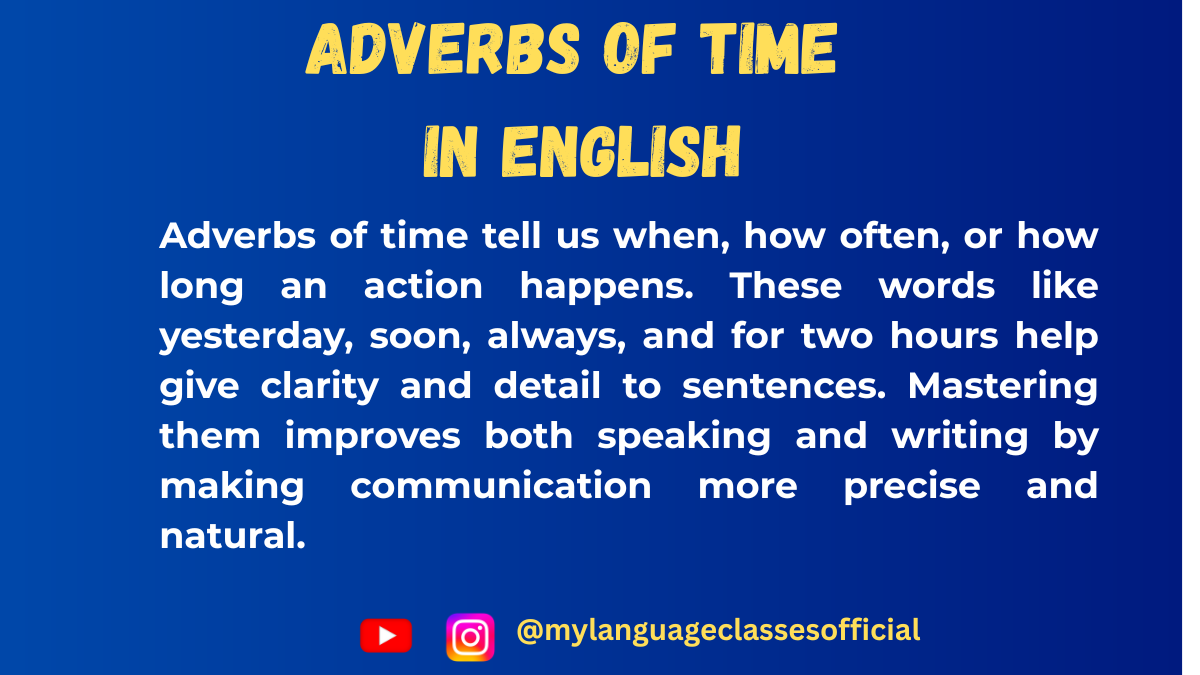Your cart is currently empty!
Tag: adverbs of time
-

Adverbs of Time in English Grammar
Adverbs of time are an essential part of English grammar, as they help describe when an action takes place. They provide clarity to sentences by indicating past, present, or future time and are commonly used in both spoken and written English.
Understanding adverbs of time is crucial for effective communication, as they allow speakers and writers to express when an event happens, how often it occurs, and for how long. Without these adverbs, sentences can lack important time-related details, leading to confusion.
In this blog post, we will explore common adverbs of time, their grammar rules, different usage scenarios, and example sentences. Additionally, we will provide a practice exercise to help reinforce your understanding of this topic. By the end of this guide, you will have a strong grasp of how to use adverbs of time correctly and naturally in your conversations and writing.
Common Expressions Using Adverbs of Time
Adverbs of time often appear in common everyday expressions that we use in conversations. These expressions help clarify when events occurred, are occurring, or will occur. Below is a list of common expressions and phrases that include adverbs of time:
- At the moment – Refers to the present time.
Example: “I’m busy at the moment.” - In a while – Refers to a short period of time in the future.
Example: “I’ll be there in a while.” - At once – Refers to doing something immediately.
Example: “Please respond at once.” - Every day – Refers to daily frequency.
Example: “I go to the gym every day.” - Right now – Refers to the immediate present.
Example: “I need your help right now.” - Later on – Refers to a time after the present.
Example: “We will discuss this later on.” - Soon after – Refers to something happening shortly after.
Example: “The meeting ended, and soon after, I left.” - At times – Indicates occasional occurrence.
Example: “At times, I feel overwhelmed with work.” - In the past – Refers to a time that has already passed.
Example: “I lived in Canada in the past.” - Once in a while – Indicates infrequent occurrence.
Example: “I treat myself to chocolate once in a while.”
Grammar Rules for Using Adverbs of Time
Adverbs of time have specific grammatical rules that govern their use. Understanding these rules will ensure that you use these adverbs correctly in your sentences.
General Structure
- Position in the Sentence: Adverbs of time generally appear at the end of the sentence, but they can also appear at the beginning or in the middle depending on the emphasis and context.
- Example (end): “She called yesterday.”
- Example (beginning): “Yesterday, she called.”
- Example (middle): “She always calls at night.”
- Use of Articles: Adverbs of time do not require articles, as they modify the verb and indicate the time of the action.
- Plural and Gender: Adverbs of time do not change based on number or gender. They are invariant.
- Types of Adverbs of Time:
- Definite: Refers to specific times (e.g., “now,” “today,” “yesterday”).
- Indefinite: Refers to general time periods (e.g., “soon,” “later,” “soon after”).
Common Adverbs of Time and Example Sentences
Here’s a list of common adverbs of time along with example sentences:
- Now: “She is working now.”
- Soon: “We will leave soon.”
- Yesterday: “I visited the museum yesterday.”
- Today: “The weather is perfect today.”
- Later: “I will call you later.”
- Before: “She had left before I arrived.”
- Afterwards: “We went for coffee afterwards.”
- Always: “I always drink coffee in the morning.”
- Never: “I never go to bed late.”
- Often: “She often goes for a walk in the evening.”
- Frequently: “He frequently travels for work.”
- Seldom: “I seldom watch TV.”
When to Use Adverbs of Time
Adverbs of time are used in various situations to give more information about the time frame of an action. Below are the key situations where adverbs of time are used, along with examples:
1. Present Time
Adverbs of time are commonly used to talk about actions happening now or regularly.
- Example: “She always drinks tea in the morning.”
- Usage: In habitual actions or routines.
2. Past Time
Adverbs of time indicate that an action occurred at a specific time in the past.
- Example: “I visited Paris last summer.”
- Usage: To describe something that happened in the past.
3. Future Time
Adverbs of time are used to express when something will happen in the future.
- Example: “We will meet tomorrow.”
- Usage: To indicate future actions or events.
4. To Indicate Frequency
Adverbs like always, never, and often describe how frequently something happens.
- Example: “I always go for a jog in the evening.”
5. To Specify Duration
Adverbs like for and since specify the length of time for which something happens.
- Example: “She has been waiting since 10 AM.”
6. To Indicate Immediacy
Adverbs like now, immediately, and right away indicate that an action is taking place at this moment or will take place immediately.
- Example: “I need to leave right now.”
Things to Keep in Mind
When using adverbs of time, there are a few things to consider to ensure you don’t make mistakes. Here are some tips and tricky points:
- Placement of Adverbs:
- While adverbs of time usually go at the end of a sentence, they can also go at the beginning for emphasis.
- Incorrect: “She will never forget this.”
- Correct: “She will never forget this.”
- Use of Tenses:
- Pay attention to the tense when using adverbs of time. For example, use yesterday with past tense, and soon with future tense.
- Avoid Overuse:
- Don’t overuse adverbs of time like always, never, and often. Using them too much can make your sentences sound repetitive.
Example Table
Here are some example sentences that demonstrate the use of adverbs of time in different contexts:
Adverb of Time Sentence Now She is eating now. Later I will visit you later. Yesterday He arrived yesterday. Tomorrow We are leaving tomorrow. Soon She will call soon. Never I never go to bed late. Always I always wake up early. Afterward We went to the park afterward. Before He left before I arrived. Sometimes I sometimes skip breakfast. Seldom She seldom eats junk food. Occasionally We meet occasionally. Frequently He travels frequently for work. In the past I lived in London in the past. Once in a while I go to the movies once in a while.
More Example Sentences
- She went for a walk right now.
- I see him frequently at the library.
- Every day, I learn something new.
- We will start the meeting in a few minutes.
- I met her once in Paris.
- I plan to finish my work soon.
- He called me yesterday.
- I will tell you everything later.
- I’m visiting my parents this weekend.
- She always helps me with my homework.
Exercise
Fill in the blanks with the appropriate adverb of time:
- I am going to the gym _______.
- She leaves work _______.
- We will have dinner _______.
- He arrived _______.
- I will call you _______.
- She comes to the office _______.
- The concert will start _______.
- I have not seen him _______.
- They will arrive _______.
- I see my friends _______.
Answers:
- I am going to the gym every day.
- She leaves work early.
- We will have dinner soon.
- He arrived yesterday.
- I will call you later.
- She comes to the office every morning.
- The concert will start in an hour.
- I have not seen him for a long time.
- They will arrive tomorrow.
- I see my friends occasionally.
Conclusion
Mastering adverbs of time is essential for clear and effective communication in English. With the knowledge of how to use these adverbs, when to use them, and the rules governing their usage, you will improve your speaking and writing skills. Be mindful of placement, tense, and the frequency of adverbs to avoid errors. Keep practicing, and soon you will use adverbs of time like a pro!
👉 Visit our blog: mylanguageclassesblog.wordpress.com
👉 Follow on Instagram for daily tips
👉 Subscribe on YouTube for fun grammar videos.Let’s grow your English fluency together—one word at a time!
- At the moment – Refers to the present time.
-

Exploring Spanish Adverbs
Adverbs are essential in Spanish, providing important details about actions—when, where, and how often they happen. Mastering adverbs will help you express yourself more clearly and accurately in everyday conversations. In this blog post, we’ll break down three important types of adverbs: adverbs of frequency, adverbs of time, and adverbs of place. Each type has its own role in enriching your sentences.
1. Adverbs of Frequency: How Often?
Adverbs of frequency tell us how often an action takes place. They are essential for describing habits, routines, and general tendencies in our daily lives. Common adverbs of frequency in Spanish include words like siempre (always) and nunca (never), which are often used to express regularity or lack thereof.
For example:
- Siempre (Always): Yo siempre tomo café por la mañana.
(I always drink coffee in the morning.) - Nunca (Never): Nunca llego tarde al trabajo.
(I never arrive late to work.)
Here’s a table summarizing common adverbs of frequency, their English meanings, and example sentences:
Adverbs of Frequency
Adverb (Spanish) English Meaning Example Sentence (Spanish) Translation (English) Siempre Always Yo siempre tomo café por la mañana. I always drink coffee in the morning. A menudo Often Ellos visitan a sus abuelos a menudo. They often visit their grandparents. Frecuentemente Frequently Los niños frecuentemente juegan en el parque. The children frequently play in the park. A veces Sometimes A veces leo libros en la biblioteca. Sometimes I read books in the library. Rara vez Rarely Ella rara vez come comida rápida. She rarely eats fast food. Nunca Never Nunca llego tarde al trabajo. I never arrive late to work. Tip: In Spanish, adverbs of frequency like siempre and nunca typically come before the verb, while others like a veces and frecuentemente can vary in position for emphasis.
2. Adverbs of Time: When?
Adverbs of time tell us when an action happens. They help us frame the timeline of a conversation, allowing us to specify moments in time—whether something happens right now, in the past, or in the future.
For example:
- Ahora (Now): Estoy estudiando ahora. (I am studying now.)
- Mañana (Tomorrow): Mañana tengo una reunión importante. (Tomorrow I have an important meeting.)
Here’s a table with some common adverbs of time and examples:
Adverbs of Time
Adverb (Spanish) English Meaning Example Sentence (Spanish) Translation (English) Ahora Now Estoy estudiando ahora. I am studying now. Hoy Today Hoy vamos al cine. Today we are going to the cinema. Mañana Tomorrow Mañana tengo una reunión importante. Tomorrow I have an important meeting. Ayer Yesterday Ayer cociné una paella deliciosa. Yesterday I cooked a delicious paella. Tarde Late Llego tarde a la clase de español. I am late for the Spanish class. Temprano Early Siempre llegamos temprano al aeropuerto. We always arrive early at the airport. Tip: When using adverbs of time, be sure to place them where they make the most sense contextually—before or after the verb depending on what you want to emphasize.
3. Adverbs of Place: Where?
Adverbs of place answer the question “Where?” These adverbs describe the location of an action. They are especially helpful in giving directions or providing specific details about where something happens. Common adverbs of place include aquí (here), allí (there), cerca (close), and lejos (far).
For example:
- Aquí (Here): Ven aquí, por favor. (Come here, please.)
- Lejos (Far): Su oficina está lejos de la estación de tren. (Their office is far from the train station.)
Here’s a table summarizing common adverbs of place:
Adverbs of Place
Adverb (Spanish) English Meaning Example Sentence (Spanish) Translation (English) Aquí Here Ven aquí, por favor. Come here, please. Allí There Dejé mis llaves allí. I left my keys there. Cerca Close/Nearby Hay un supermercado cerca de mi casa. There’s a supermarket near my house. Lejos Far Su oficina está lejos de la estación de tren. Their office is far from the train station. Dentro Inside El gato está dentro de la caja. The cat is inside the box. Fuera Outside Los niños juegan fuera. The children play outside. Tip: Adverbs of place often go after the verb, but they can sometimes appear at the beginning of the sentence for emphasis.
Final Thoughts
Adverbs are powerful tools in Spanish that help add context to your sentences. By using adverbs of frequency, adverbs of time, and adverbs of place, you can make your speech or writing much more expressive. Practice using them in different contexts, and soon they will become a natural part of your Spanish communication.
¡Buena suerte en tu aprendizaje! (Good luck with your learning!)
If you enjoyed this lesson, be sure to check out more posts like this on my blog at My Language Classes. Don’t forget to subscribe my YouTube channel and follow me on Instagram for the latest language learning tips and lessons. Leave a comment below to share your thoughts, or ask any questions you have.
Happy learning! 😊
- Siempre (Always): Yo siempre tomo café por la mañana.

